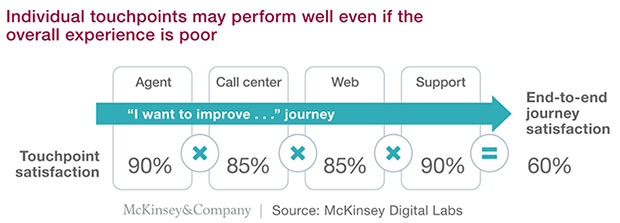Consumers have been adopting disruptive digital technologies in their daily lives at a rapid pace. Customers went from being limited to brick-and-mortar stores to researching, comparing and buying a company’s products and services online. Along with those shifts came a change in how customers communicate with companies.
Today, no matter what channel customers use to interact with a brand — phone, email, text, chat, online communities — companies must be able to create positive, consistent and engaging customer experiences.
Customer experience, or CX, is on the top of many CEOs’ minds, research consistently shows. In fact, at a recent gathering of nearly 200 CEOs, a new definition of the
purpose of a corporation emerged. Among the many things discussed at the meeting: Being internally focused on things like shareholder value is no longer the priority it once was.
Instead, customer-centric CEOs are putting their most important stakeholders, customers and employees, at the top of their agendas — and with good reason. Organizations that put customers first
outperformed laggards on the S&P 500 index by nearly 80 percent.
These brands retain a higher share of wallet and have customers that are seven times more likely to purchase more from them, eight times more likely to try other products or services, and 15 times more likely to spread positive word of mouth, the research shows.
What is one of the top initiatives this gathering of CEOs agreed to? Delivering value to customers and furthering the tradition of American companies to lead the way to meet or exceed customer expectations. This puts customer experience front and center. It’s clear theses customer-centric CEOs are convinced customer experience is the key to building the kind of sustainable advantage that leads to better business outcomes, long-term success and a strong competitive advantage.
CEOs have a unique and vital leadership role in creating this competitive advantage through the customer experience. Let’s face it. Employees look to their leadership to know what is important. If the CEO is standing firm on accelerating customer experience, it naturally becomes the internal mantra within a company.
It gives employees the leeway to do the right thing when it comes to making sure a customer’s experience is topnotch: Everyone’s focus, from upper to middle management to frontline employees, changes to prioritize the customer. It sounds simple, but many companies don’t really put their customers first.
CEOs as CX Leaders
The seven characteristics of a customer-focused CEO, outlined in a
report by Walker Info, are as follows:
- Uses insights strategically: Believes CX is not just a program, but a holistic strategy that permeates every aspect of a business, from the front office to back-end systems, people, processes and technologies;
- Sets aside short-term financial gain: Focuses on a long-term strategy with the ultimate goal to drive amazing end-to-end customer experiences;
- Seeks the broader customer story: Engages across the customer base and not just with top customers; digs deeply to identify common issues, trends and needs;
- Coordinates across silos: Incentivizes employees to collaborate, eliminating politics, hero cultures and “getting credit”; rather, encourages through performance objective focusing on the customer’s needs and wants;
- Encourages empathy for customers: Ensures the culture is focused on seeing the customer’s point of view and journey with the company instead of designing systems, technology and processes around the company;
- Requests information, advice: Relentlessly pursues ways to elevate competitive advantage strategically by using insights daily from employees, customers, suppliers and partners; and
- Makes the call on resources: Ensures all the resources required to create great customer experiences are plentiful in order to deliver on great customer journeys.
Choose Customer Journeys Over Touchpoints
For a company to become customer-centric, the CEO must work with all the various parts of the business — back-end operations, marketing, sales, service — while shifting the whole company’s focus from customer touchpoints to customer journeys.
This might seem like a very tactical endeavor for a CEO, but without it the senior leadership team frequently must rely on direct reports, who often are motivated to tell their bosses and the CEO what they want to hear, instead of what they need to hear.
When direct reports are not accustomed to being honest about the customer experience, they may gloss over issues, putting political career agendas in front of what best for the customer. Over the long run, this is detrimental to the company. Because the devil is in the details, when designing and delivering a great customer experience journey, honesty is paramount.
Focusing on customer journeys correlates more strongly with business outcomes than focusing on touchpoints, McKinsey
researchers have found.
For example, when health insurance companies get the customer journey right, customer satisfaction is 73 percent more likely than when they focus only on getting touchpoints correct, the research indicates. In the hospitality industry, hotels that get the customer journey right find 61 percent of their customers are more willing to recommend the brand to other customers than when they focus merely on touchpoints.

Certainly, to lead and train an organization to see the world through the customer’s eyes takes patience and guts. Understanding the customer journey, from the time customers hear about a company (through advertising and marketing) to when they are offered the product or service (sales) to when they reach out to a company for questions or support (customer service and back-end operations) is key. Everyone in the company has to be focused on what that overall, end-to-end customer experience journey is like for the customers.
With many departments traditionally operating as silos, parts of the customer experience journey are sure to fall through the crack. If departments aren’t collaborating, they won’t know when the ball has been dropped along a customer’s journey or who should pick it up again.
An effective customer experience requires using advanced customer analytics to discover where there are holes in the process. Designing an organization to be of service to the customer also requires strong leadership in organizational change management. That’s because to transform customer experience journeys means not just changing technologies and processes, but also improving and changing the internal operations, politics and company culture, along with the attitudes of those who deliver that customer experience, either directly or indirectly.
The Science of Customer Engagement
You might be wondering what exactly is customer experience? It is really about the emotional connection a customer develops during interactions with a company. Think about the last time you ordered something from a company. What was the experience like? How easy was it to find what you were looking for? Was it simple to get your questions answered in a timely manner? Did you find the people and systems you depended on easy to use, or did you leave frustrated?
What happened when you went to get service? Was the interaction with either the company’s self-service capabilities or customer service agents satisfying? Did it leave you feeling like this company really had your back? Or did you wonder, “What on earth are they thinking? I’d never do business with them again!” If you had that bad experience, did you find yourself eager to tell your friends and family, sharing it both in-person and online for all to see? Customer experience is that emotional response to interacting with the company.
When Customer Interaction Turns to Customer Engagement
If the interaction with the company is easy, seamless and not frustrating, that interaction can turn to engagement. This is key, because it’s only when interactions lead to engaged customers that companies see higher customer satisfaction, loyalty and excitement about their products and services. Companies that successfully navigate a customer’s experience do so by creating opportunities for positive emotional connections through ongoing, consistent and memorable interactions.
Enhancing the Customer Experience Is Lucrative
It pays off to transform the customer experience, the research shows. Brands that are effective at leveraging customer experience grow at significantly faster rates than the market.
Increasing customer retention rates by 5 percent
increased profits by 25 percent to 95 percent, Bain and Company showed.
In addition, a reduction in costs can be obtained by analyzing the customer journey to identify any inefficiency issues. Companies that use customer journey maps to guide their process changes see a 15-20 percent
reduction in their cost of service, according to a report by McKinsey.
Instead of spending money on things that don’t work, the company can use part of the money saved to improve the customer experience, innovate product offerings, or give raises and bonuses to people who deliver exceptional customer experiences.
Not examining the customer journey means wasted money, poor customer experiences, and in the long run lower revenue, profits and margins. With these types of statistics illustrating the importance of customer experience to overall business success, it’s easy to understand why CEOs are solidly focused on CX and know the value their CX professionals bring to their organizations.
Working With Your CEO on Customer Experience
If you are working on a customer experience initiative and only have 30 minutes to spend with your CEO, do you know what your CEO and senior leadership teams need to know from you?
Understanding what’s important to them is valuable intelligence to help align a CX professional’s work with the strategies of the C-suite. It’s key to ask them what their priorities are. There are some
priorities for CX professionals to focus on, additional research from Walker Info shows. Here are some ideas to get your started on your own customer experience journey with your CEO:
- Understand CEO’s priorities for transforming or elevating the customer experience;
- Map your current customer journeys, understanding the gaps and why the customer experience may be lacking;
- Determine what it would take to close the gaps to create more seamless customer interactions that result in customer engagement;
- With the gap analysis, create short-term and long-term goals and plans;
- Align your CX efforts with the business outcomes, and prepare to show the CEO and senior leadership team how CX initiatives can result in concrete outcomes;
- Aim not only to lead “break-fix” activities in your customer journeys, but also to innovate the customer experience; it’s the only way to stay ahead of the competition;
- Build a dedicated, customer-focused workforce by giving employees a voice in designing and delivering the customer experience;
- Communicate your findings to your CEO and agree on a working plan;
- Review the progress, pivot, and iterate as you learn what works and doesn’t; and
- Commit to a lifetime of creating amazing customer experiences for your customers by continuously repeating these steps.



 Natalie Petouhoff works with customers and companies to choose the right people, process, and technology to innovate a company’s customer and employee experience. Dr. Natalie brings to her writing years of experience as a strategic executive customer service advisor. She has served as a contact center analyst at Forrester, CRM management consultant at PWC, and chief digital/social officer at Weber Shandwick. She is also a social customer service ROI expert. Dr. Natalie has authored more than hundreds of white papers, e-books, articles and webinars. Her opinion as a thought leader is highly sought by reporters and she has been quoted in The New York Times, FastCompany and Forbes as well as CRM Buyer.
Natalie Petouhoff works with customers and companies to choose the right people, process, and technology to innovate a company’s customer and employee experience. Dr. Natalie brings to her writing years of experience as a strategic executive customer service advisor. She has served as a contact center analyst at Forrester, CRM management consultant at PWC, and chief digital/social officer at Weber Shandwick. She is also a social customer service ROI expert. Dr. Natalie has authored more than hundreds of white papers, e-books, articles and webinars. Her opinion as a thought leader is highly sought by reporters and she has been quoted in The New York Times, FastCompany and Forbes as well as CRM Buyer.

